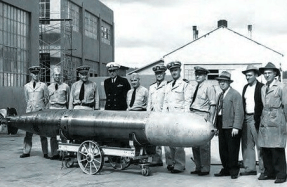OUT OF THE DEEP


From the sea, McVay saw his ship standing on end, its stern towering over him.
The Philippine Sea
Just after midnight
The first torpedo slammed into the heavy cruiser USS Indianapolis’s starboard bow, killing dozens of men in an instant. The violent explosion ejected Captain Charles B. McVay III, 47, from his bunk in the emergency cabin just aft of the bridge. The ship whipped beneath him and set up a rattling vibration that took him back to Okinawa four months earlier.
Had they been hit by another suicider?
No, McVay thought. Impossible.
Another shattering concussion rocked Indy amidships. Acrid white smoke immediately filled McVay’s cabin. He picked himself up off the deck, felt his way to the cabin door, swung around the bulkhead, and appeared on the lightless bridge, stark naked. At that moment, there were 13 men on the bridge; only three would survive. For the captain and many others, a nightmare that would span decades was just beginning.
Fifteen hundred yards from Indianapolis, aboard the Imperial Japanese submarine I-58, Lieutenant Commander Mochitsura Hashimoto peered through his night periscope at the scene of destruction unfolding quickly before him.
“A hit! A hit!” he shouted. His elated crew improvised a victory dance.
To ensure he struck the American cruiser even if it had zigzagged—a maneuver for evading torpedoes the ship was almost sure to make—Hashimoto had fired six Type 95 oxygen torpedoes in a fanwise spread. His tactic had worked. Now, on the target’s main and after-turrets, skyscrapers of silver water shot toward the moon. Red tongues of flame followed immediately after, tasting the night.
Hashimoto had watched the enemy send many of his fellow submarine commanders down to salty underwater graves and feared that he would fail to take a prize for Japan before the war was lost. Filled with joy, Hashimoto prepared to send a message to his commander in chief: I-58 had torpedoed a large American warship.
Aboard , Captain McVay was trying to verify that a distress signal had been transmitted when a wall of water swept him from the ship along with hundreds’s massive screws kept up a lazy turning, while all around them the phosphorescent water glowed like green fire.
You’re reading a preview, subscribe to read more.
Start your free 30 days





